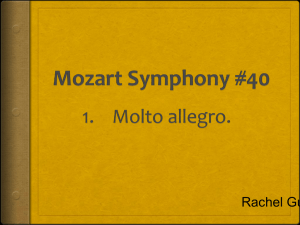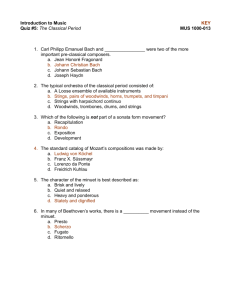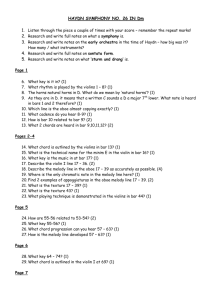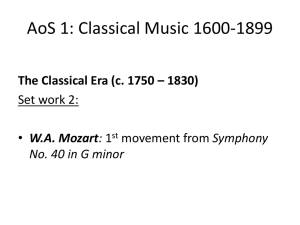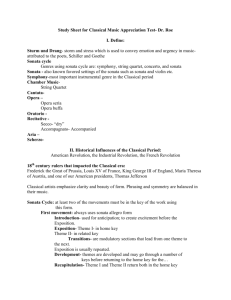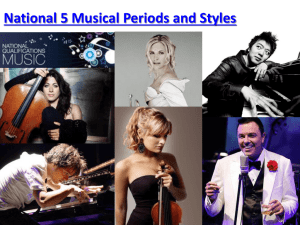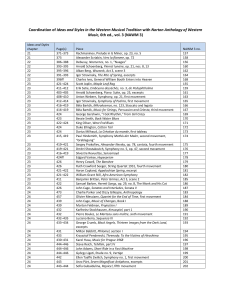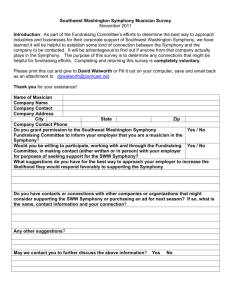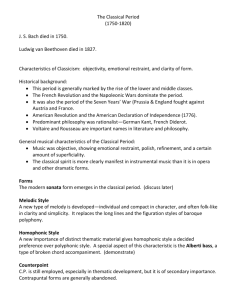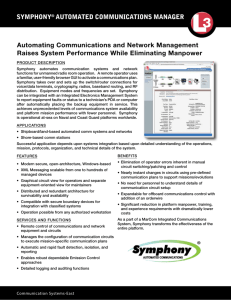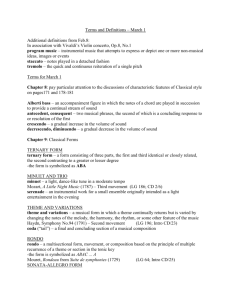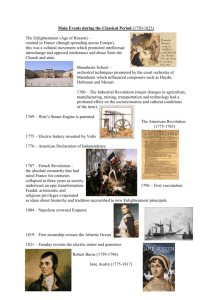GCSE Music
advertisement
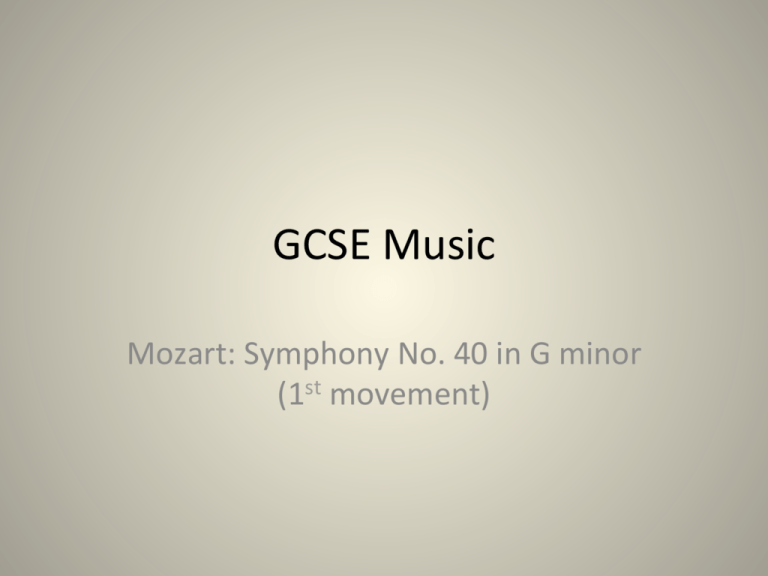
GCSE Music Mozart: Symphony No. 40 in G minor (1st movement) Learning outcomes What? • Learn about the context of this set work. • Understand its structure. • Know some of its musical features. How? • Through listening with scores. • Through a research task. • Through answering some quesPons. Why? • To know the set work for the listening exam. Wolfgang Amadeus Mozart 1756-­‐1791 Context • This symphony was composed in 1788 (in the Classical era). • It was Mozart’s penulPmate symphony (he wrote 41). • Four movements (we only study the 1st). • Mozart was a child prodigy. His father was a composer and performer and encouraged his son to entertain emperors and heads of state from an extremely young age (4). • Mozart only lived to the age of 35, but sPll had a huge output musically. He composed symphonies, sonatas, concertos and operas as well as many other works. • • • • • • • • • The Classical Era: features c. 1750 – 1830 Clear, light and balanced textures with melody and accompaniment most popular (homophonic texture most common). Simple, memorable melodies (quesPon & answer phrasing & symmetry). Structures used have a sense of balance/proporPon (sonata form, rondo form, etc.). Orchestra was standard ensemble used. Mozart, Haydn & Beethoven (the ‘big 3’). Piano and clarinet invented. Dynamics – composers now used gradual changes (crescendo/ diminuendo) and more dynamic shading. Dynamics used more expressively. Pieces now frequently incorporated changes of mood (not just one emoPon/affecPon explored in one piece). Research quesPons 1. What is a symphony? 2. How many movements does a symphony normally have? 3. What kind of structure does the 1st movement of a symphony normally have? 4. What can you find out that is unusual about this symphony by Mozart? Answers 1. What is a symphony? A piece of music for orchestra that was one of the most popular large-­‐scale genres invented during the Classical period. 2. How many movements does a symphony normally have? Four (fast-­‐slow-­‐minuet & trio-­‐fast). 3. What kind of structure does the 1st movement of a symphony normally have? Sonata form structure. 4. What can you find out that is unusual about this symphony by Mozart? Mozart uses quite a small orchestra (there are no trumpets or drums) with only 7 woodwind players and 2 horns. He also uses sonata form in the second and last movements, which is unusual. Sonata form Learning Outcomes What? How? Why? • Learn about features of Classical music. • Learn about the musical features of this movement. • Understand how to analyse music. • Through a research task. • Through listening with scores. • Through use of analysis. • Through answering some quesPons and plojng analysis on scores. • To know the set work for the listening exam. Success Criteria All Most Some • Will akempt to answer the quesPons. • Will plot some analysis on scores. • Will answer quesPons successfully. • Will plot all important analysis on to scores. • Will answer all quesPons well, with a strong understanding of this work. • Will plot percepPve analysis on to scores. Breakdown of the sonata form in this movement Exposi@on First subject (1-­‐20) Bridge passage (20-­‐44) Second subject (44-­‐72) Codeka (73-­‐100) Development (101-­‐164) Recapitula@on First subject (164-­‐184) Bridge passage (184-­‐227: much longer this Pme!) Second subject (227-­‐260: this Pme stays in tonic key) Coda (260-­‐299: similar to codeka but longer) Main musical features • • • • • • • G minor is tonic key. In sonata form. Melancholy or ‘pathéPque’ mood. Fast tempo (‘Molto Allegro’). 4/4 metre. Regular phrasing (8 bars). Modulates to relaFve major for second subject. Answer these quesPons in your book 1. What is the form of this movement? 2. What is unusual about the movement? 3. What do we mean by ‘first and second subjects’? 4. What is the purpose of the bridge passage? 5. How would you describe the mood of this movement as a whole? st nd Melody: 1 and 2 subjects • 1st subject: • 2nd subject: Melody: sequence • What is sequence? A melody/moFf that repeats, but starFng on a note higher or a note lower (think of ‘Ding Dong, Merrily on High -­‐ Gloria’!). • IdenPfy where Mozart uses sequence in some parts of this movement. Melody: the development secPon • Look at the development secPon of the piece. Which melodic idea is the enPre development based on? The first subject. Texture 1. With a partner, come up with a definiPon for each type of texture: -­‐ Monophonic -­‐ Homophonic -­‐ Polyphonic 2. Now look at/listen to the Mozart movement again and try to find examples of each type of texture. What are your conclusions? Texture • The texture in this movement is mainly homophonic! = MELODY + ACCOMPANIMENT Tonality & Harmony 1. What is the key of this movement (and the whole symphony)? G minor. 2. Which key does the music move to by the second subject? B flat major – the relaFve major (shares a key signature with G minor of 2 flats). 3. In the recapitulaPon, is the second subject in B flat major? Why? No, because the music needs to stay in G minor (the tonic) to end. Tonality & Harmony • The exposiPon ends in B flat major (relaPve major). What chord does it end on? A D7 chord (a dominant 7th in G minor!!) • The development secPon starts in G minor again, but does not stay in it. What happens? The first Gm chord is followed by a diminished 7th chord (F-­‐G#-­‐B-­‐D) • The development secPon moves through many different keys. Mark some into your score. Tonality & Harmony • Look for some examples of cadences, too: e.g.: perfect (b. 27-­‐28, 50-­‐51, 71-­‐72, 79-­‐80) • The recapitulaPon is in the tonic key (Gm) and stays there! The first subject is a direct repeat of when it appeared in the exposiPon. • Look at the coda from b. 293-­‐299. Which two chords alternate? Gm & D (I & V/tonic & dominant) Dynamics • See how many dynamic markings you can spot in your score. Write down the different ones. • Now work in 4s and make sure you have definiPons of each dynamic and what it means. • If you get stuck, send a roving reporter to another group! Highlight examples of the following on your score: 1. An example of sequence. 2. A dominant pedal. 3. ModulaPon to the relaPve major (B flat). 4. Sustained woodwind chords. 5. Perfect cadence (V-­‐I). 6. Sforzando chords. 7. Use of semitones/chromaPc movement. 8. Falling moPfs (represenPng ‘sighing’ – ‘PathePque’!). 9. Parts swapping melodic ideas. 10. Unison violins (all playing the same thing). 11. An idea being passed between instruments. 12. AugmentaPon (rhythms being ‘stretched out’). 13. A long extended perfect cadence. 14. A diminished seventh chord (G#-­‐B-­‐D-­‐F). 15. A tempo marking. 16. A counter-­‐melody. 17. The first 3 notes of the first subject being passed around. 18. A dramaPc change in texture. 19. The second subject in the tonic key (G minor). 20. ‘Tuj’ (whole orchestra) playing. QuesPons 1. Give 2 features of the development secPon. 2. What key is the second subject in during the recapitulaPon, and why? 3. The final secPon is the coda. What does Mozart develop further during this final secPon? 4. What is the role of the 2 horns in this piece and why is one in the key of G minor and one in B flat major? 5. How would you describe the mood of the movement as a whole? Give 3 musical reasons. 6. How many other movements are in the rest of the symphony?
